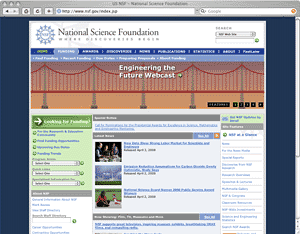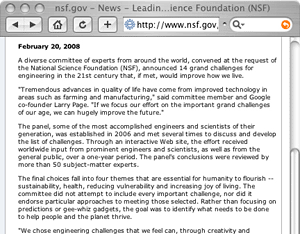Overseas News on Civil Engineering IT
|
|
This section focuses on a unique overseas website related to civil engineering IT. This issue features "National Science Foundation (NSF)", which is the federal government's agency dedicated to support education and fundamental research in scientific and engineering disciplines.
To Support Promising Fundamental Research and Education in Leading-edge Fields, with Many Nobel Prizes Brought About
NSF is an independent federal agency established in 1950 "to promote the progress of science; to advance the national health, prosperity, and welfare; to secure the national defense..." They take on a mission to ensure that the United States maintains leadership in scientific discovery and the development of new technologies.
As a historical background, with a host of scientific contributions made to American victory in the Second World War, continuous Federal support of science and research was considered essential to the defense and welfare of the United States after the war. Originally set up in Washington, D.C., NSF has now its headquarters in Arlington, VA.
According to the above Web site, NSF is the only federal agency whose mission includes support for all fields of fundamental science and engineering, except for medical sciences. Its important task is positioned to keep the United States at the leading edge of discovery in a wide variety of scientific areas.
Therefore, in addition to funding research in the traditional academic areas, NSF also has a policy to support so-called "high-risk, high pay-off" ideas, novel collaborations and projects that may seem like science fiction at present, but which the public will take for granted in future. In every case, NSF intends to ensure that the selected research is fully integrated with education so that today's revolutionary work will also be training tomorrow's top scientists and engineers.
The outcome of NSF activities is proved by the fact that NSF-funded researchers have achieved more than 170 Nobel Prizes, including discoveries of many of the fundamental particles of matter, or decoding the genetics of viruses. More detailed information about Nobel Prize can be reached by selecting "NSF at a Glance" at the Home page of the Web site and the words "170 Nobel Prizes" in the text.
Role and Organization of NSF
At present, NSF has an annual budget of about 6 billion dollars. The Web site says that it serves as the funding source for about 20 percent of all federally supported basic research conducted by America's colleges and universities.
NSF fulfills its mission mainly by issuing limited-term grants to fund specific research proposals that have been judged the most promising by a rigorous and objective merit-review system. Currently about 10,000 new award are granted per year. Most of these awards go to individuals or small groups of investigators, though others provide funding for research centers or facilities that allow experts to work at the outermost frontiers of knowledge.
NSF's goals, including discovery, learning, research infrastructure, and stewardship, provide an integrated strategy to advance the frontiers of knowledge, cultivate a world-class, broadly inclusive science and engineering workforce and expand the scientific literacy of all citizens, build the nation's research capability through investments in advanced instrumentation and facilities, and support excellence in science and engineering research. In other words, this is the reason why NSF call itself "where discoveries begin."
NSF leadership has two major components: a director who oversees NSF staff and management; and a 24-member National Science Board (NSB) that meets to establish the overall policies of the foundation. The director and all Board members serve six year terms, and are appointed by the President of the United States. NSF has a total workforce of about 1,700 at its headquarters. Adopting not a "top-down" but "bottom up" process, NSF keeps close track of research at home and abroad, monitors which areas are most likely to result in spectacular progress, and chooses the most promising people to conduct the research.
Identifying 14 Grand Engineering Challenges in the 21st Century Including VR
NSF Web site presents news from NSF as well as television programs, films, museum exhibits and events supported by NSF. Moreover, the site includes information for researchers on grant application, the annual financial report of NSF, press release, classroom resources available for school education, investment information, statistics, etc.
Among these, 14 grand challenges for engineering in the 21st century were announced as news dated February 20, 2008.
According to the news, a diverse committee of experts from around the world, convened at the request of NSF (chaired by former U.S. Secretary of Defense William J. Perry) first examined and developed the list of 21st century grand engineering challenges that could improve quality of life in the future. Through an interactive Web site, the effort received worldwide input from engineers and scientists, as well as from the general public, over one year. Further review was made by experts of each subject matter. Finally, 14 items were chosen that fall into four themes essential for mankind to flourish -- sustainability, health, reducing vulnerability, and increasing joy of living.
The committee decided not to rank these 14 challenges, and the National Academy of Engineering (NAE) is offering the public an opportunity to vote or to provide comments at the project Web site.
The 14 challenges include such subjects as solar energy, energy from fusion, nitrogen cycle management as well as subjects from first-of-the-art IT fields like "Enhance virtual reality" and "Secure cyberspace". Also, as a subject that relates to construction, "Restore and improve urban infrastructure" is listed.
 |
 |
|
National Science Foundation (NSF) (Reprinted by courtesy of NSF) |
"21st Century grand engineering challenges" (Reprinted by courtesy of NSF) |
This article is written based on the above Web site with the permission of NSF.
 |
 |
 |
||
| BACK | LIST | NEXT |